Everything gets to be dewy and succulent for a moment, however brief.
And if you play it right, it’s just enough. (Barely.)
But enough.
(Happy weekend!)
Everything gets to be dewy and succulent for a moment, however brief.
And if you play it right, it’s just enough. (Barely.)
But enough.
(Happy weekend!)
More detailed information on living walls keeps trickling in, this piece from today’s LA Times, where Emily Green takes a contrarian stance. I have to admit, I’ve been silently skeptical but nevertheless reading all I can on this trend. The jury is still out on how resource intensive these creations will ultimately be or their efficacy in performing carbon sequestration, whether they will be the cure for “sick” building syndrome, but I think we can all agree that, visually, they’re simply irresistible.
Amidst all the hubbub, some intrepid souls have been quietly doing their own experimenting with the basic concept of growing plants vertically.
In September 2007 the LA Times reported on a living fence in an article entitled “Fence As Living Mural.” Using the definitions from the ASLA Sustainable Design and Development blog link that Ms. Green provides in today’s LA Times piece, this would fall under the category of a “fedge,” which “consist[s] of a framework structure that keeps the system upright, vegetation layers and an internal growing medium such as soil.”
I don’t live far from this home, so have been keeping on eye on the fence’s progress. Here’s photos I took of this living fence/fedge this morning.
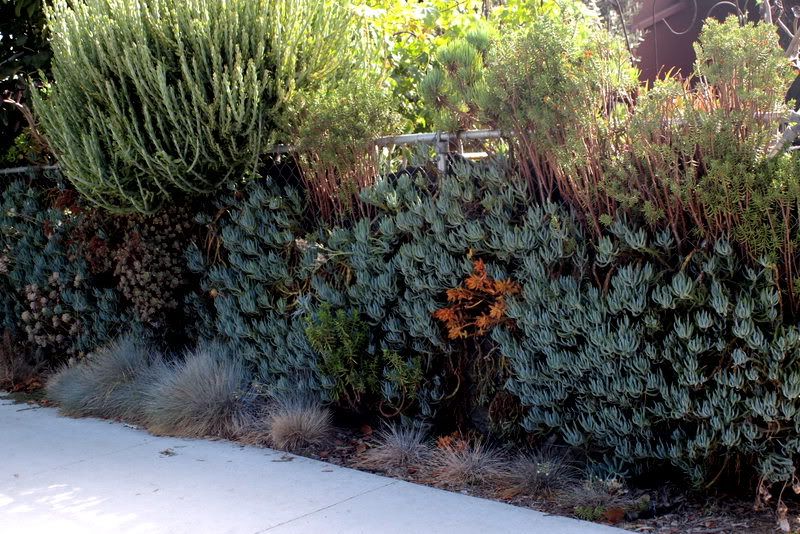
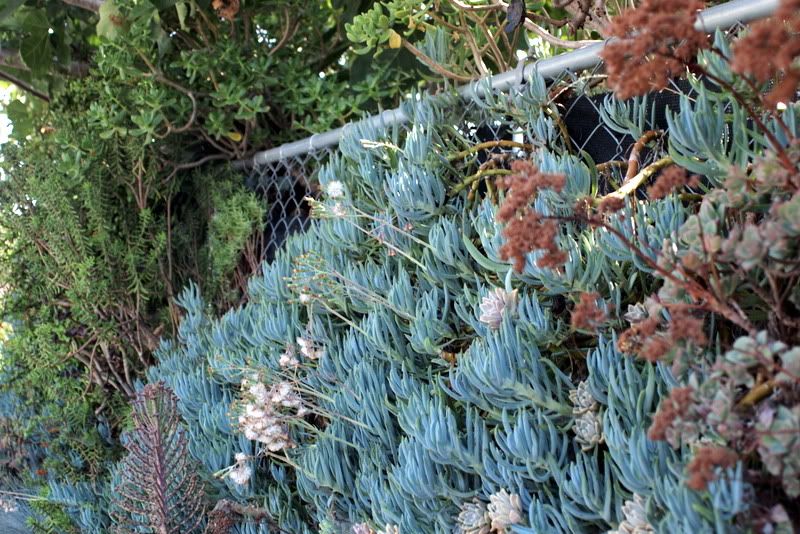
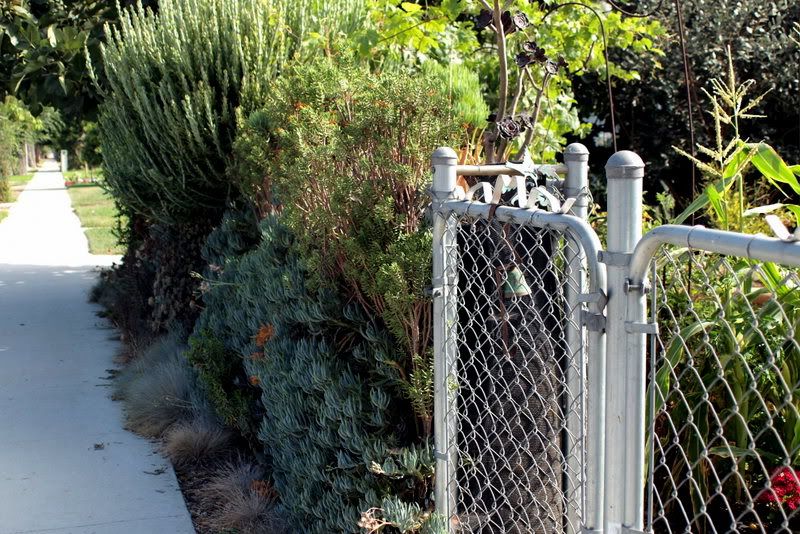
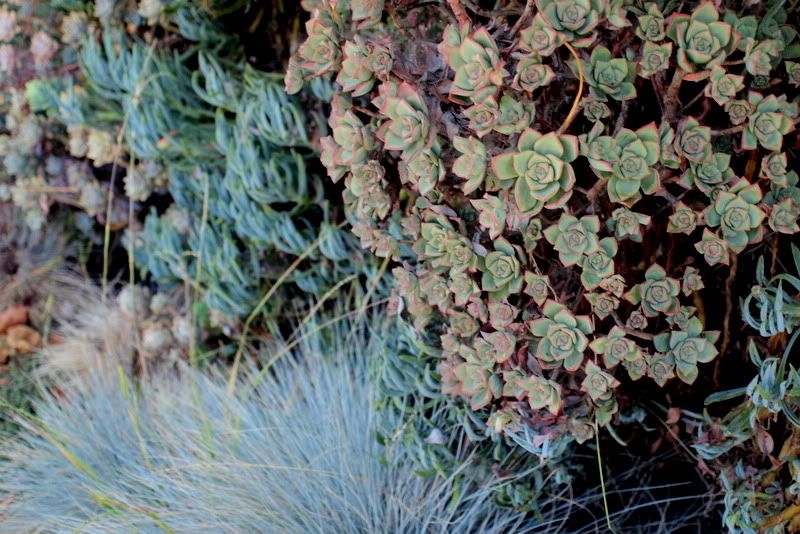
Kalanchoe daigremontiana, the mother of thousands, should only be unleashed with the utmost care. The MOT has met its competitive match on this fedge.

This is a closeup of that glorious bulge in the center of the fence, seen best in the first photo. I’m guessing it’s a plant that proved too large for the fedge, that’s now being topped to keep it in scale, resulting in this incredible textural explosion. I need a name! (Edited to add: Senecio anteuphorbium)
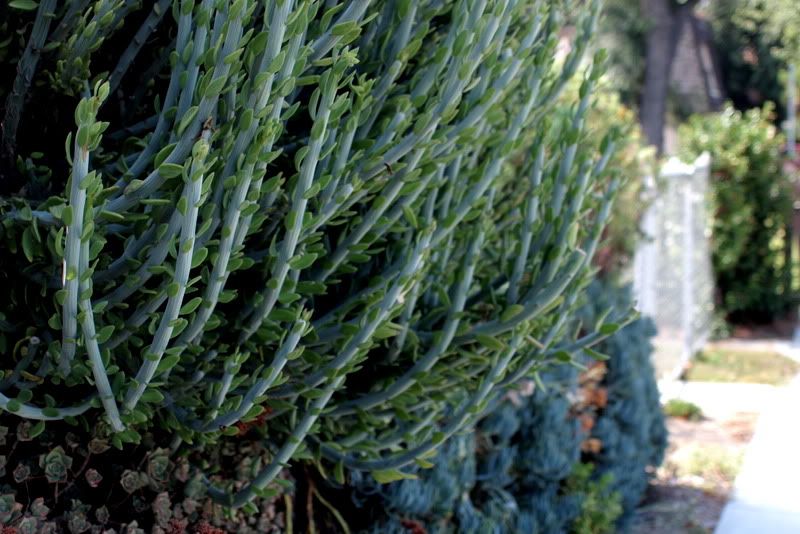
A closeup of sedum on one of my mossed creations, which puts their intricate patterns at eye level.
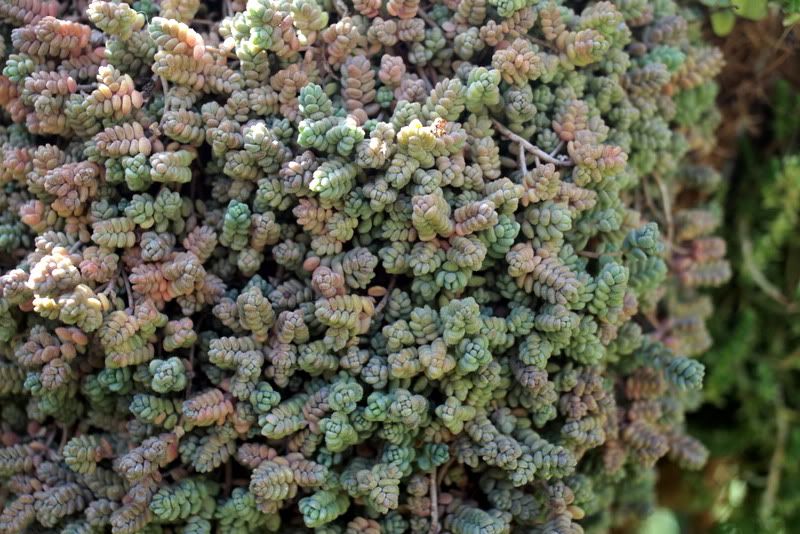
I’ve got to admit, though, that I’m not a fan of the aesthetics of the Woolly Pockets, even knowing that their green credentials are impeccable.
I get enough eye rolling at home over my outre mossed creations. Still, the more experimentation, the sooner we’ll figure out what works.
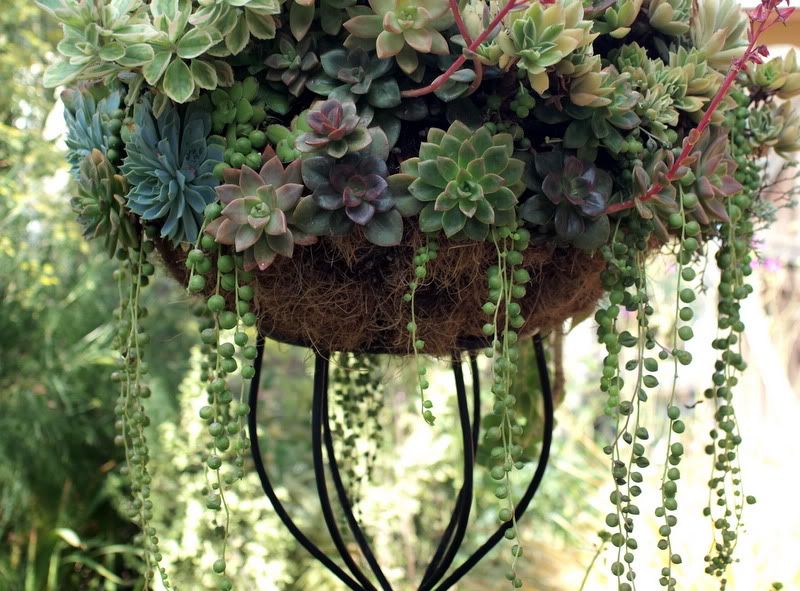
Driving for work or errands, I can find myself passing by and through endless suburban housing subdivisions which look as though they’ve been dozing through the controversy over whether to keep or lose the front lawn. (This is Los Angeles, Mediterranean climate, roughly 33 degrees latitude, zone 10, winter rain/summer dry, averaging 15 inches of rain a year.)
On my own street, however, the front lines of the controversy are drawn for all to see.
Gilbert has been sifting nutgrass out of his lawn, like we did decades ago when losing the lawn. Gilbert is keeping the lawn.
Nutgrass has the survival savvy of cockroaches, but it can be vanquished. (Raising arms in victory.)
Psst. Across the street, Holly’s away for a couple weeks, and while I’m checking up on the temporary caretaker’s diligence with watering duties, let’s take a quick tour, shall we?
Holly commenced life without the lawn last August and has done the majority of the work herself. I believe initially she had some day help with removing the grass.
I’ve given her some plants, and she’s bought some shrubs in gallon sizes, but the biggest expense has been the pavers and gravel, about $1,000. The bark is temporary while Holly saves for more gravel, but her instinct to mulch has paid off in beautifully thriving plants. With the lawn gone, Holly putters and plays in her front garden, instead of just passing through to get to the front door. Small stones are stacked into different configurations every time I visit, new vignettes appear. Bella, the German shepherd, does an amazing job of avoiding stepping on the plants and keeping to the paths.
A city rebate, the Lawn to Garden Incentive Program, offering $2.50 for plants per square foot of lawn removed, maximum of 1,000 square feet, has already blown through the $250,000 dedicated for homeowners replacing grass lawns in front yards and parkways with “California friendly” landscaping. There’s even billboards and buses around town promoting going lawnless. But I don’t underestimate the difficult step this represents for many people, workwise, designwise, and, yes, moneywise. The LA Times ran this piece recently on the dry garden, and the cash outlay was about 10K. One of the most ingenious solutions I have seen was a small bungalow in Venice, California, that turned the front walkway into a bridge to the front door, now spanning a water garden on either side, where the lawn used to be. With much of the housing stock designed to include lawn, it’s not going to be an easy transition.
Sleepy suburbs beware. In arid Los Angeles, it’s becoming increasingly more difficult to ignore the lawn v. lawnless controversy.
I’ve been busy moving this little blue grass, Carex glauca, (really a sedge) to various spots the past few days. This photo, with Echeveria nodulosa, is from May 2010.
A couple prominent blue echeverias have been sustaining heavy snail damage all summer. This morning I once again noted the disgusting appearance of their chewed-up leaves but, instead of sighing and looking away, realized here’s a perfect place for the little blue grass to flaunt its immaculate good looks.
A 6-inch gap between the bricks and Miscanthus ‘Gold Bar’ has been staring at me all summer. Another opportunity for the little blue grass to finish off an edge, it occurred to me yesterday morning.
And this little grass, only 5 inches or so high, is so tough that when the blinding thought occurs that its presence is also immediately required elsewhere, no matter how clumsily you separate it from the main clump, it doesn’t complain. Today I pried a large clump away from this spot it shares with Sedum nussbaumerianum. I hadn’t noticed the typical sedge blooms until I started digging it up, they’re that insignificant.
Double-checking its growing requirements today, I found a wide range of advice, from needing even moisture to drought tolerant. It handles both conditions in my garden. It’s also called Carex flacca, and the San Marcos Growers site says it even tolerates light foot traffic. Now, there’s an idea worth exploring, a nice blue ruff among pavers, for instance, where it loves to grow anyway. In my zone 10 garden about a mile from the ocean, this little blue grass is one tough monkey for full sun and shows good drought tolerance, but at the same time isn’t terribly invasive either, though it does spread slowly by stolons. The one failure to report was a western exposure, no supplemental irrigation, and occasionally having to withstand the wheels of my son’s Miata, a lot to ask of any grass.
It’s a great little sedge that I don’t hear much about, that I tend to take for granted because it goes about its business without any fuss or drama, but now I’m beginning to see spots for it everywhere. Zoned for at least 5-9, with some reports to zone 4.
Not quite sure how this happened. I didn’t seek out pink.
But it arrived anyway, on some great plants like the annual knotweed, Polygonum orientale, a 6-footer with splashy variegated leaves.
And when I decided to go passiflora shopping, ruddy pink arrived on the diminutive passionflower P. sanguinolenta. (Passiflora grows like kudzu in zone 10, and a judicious selection is key.)
This may not be the passionflower for me, so it’s confined to a pot for now. If I’d known they bloom on such small plants, lots more summer containers would be draped with passionflowers.
Palest pink hitched a ride on the maple-leaved begonia, B. partita.
And snuck in on cat’s paws with this Asarina scandens vine, which I could’ve sworn was labeled a white variety.
More reddish pink arrived when, having to choose an iochroma, I decided against the purple. Orangey-gold would have been preferable. (Is there a gold iochroma?)
But with such a great plant, choosing the flower color is just quibbling. Pick one or the other or another color, but choose iochroma, even if only for containers where this tropical is not hardy.
The red is Iochroma coccinea. I have no idea now why I decided against purple. Probably because the red is less ubiquitous, but that would be a silly reason, right?
Not that there’s anything wrong with pink. I’m just surprised there’s so much this summer.
This little tropical area is almost a ghetto of pink flowers. But choice has always been guided by consideration of the overall plant first, with color last for me.
So some summers, getting pinked occasionally happens. For “pink eye,” Euphorbia mellifera is the perfect antidote. So soothing.
And the big leaves of the ‘Siam Ruby’ banana are helping to keep everybody in line as well.
Saturday night at Cinema Botanica. It was only a matter of time before I dragged movies into this blog ostensibly about plants. I’ve wanted to see this movie since it was released a decade ago, so I’m definitely late to this show. I knew it was a slow, elegant mood piece, and just the right moment to savor it had to be found. As long a wait as it was, now I’m thankful some movies this good are left in reserve. I knew it would be a visual knockout, that Maggie Cheung’s qipaos had caused a commotion when the film was released. But watching her walk in these gorgeous dresses is to witness the crowning glory of human bipedalism. It is these qipaos that rate this film a slot in the Cinema Botanica, or one dress in particular. You can’t miss it. The shock of that huge daffodil on the pale, straw-colored bodice had me gasping out loud. What a bizarre but bold idea, and the perfect touch for a movie partly about a woman stoically holding on to her self-esteem while her husband spends his passion on interminable “business trips.” The passage of time is subtly handled, and what may seem like an extended dinner scene is actually several dinners, as quietly revealed through the changing qipaos worn by Ms. Cheung.
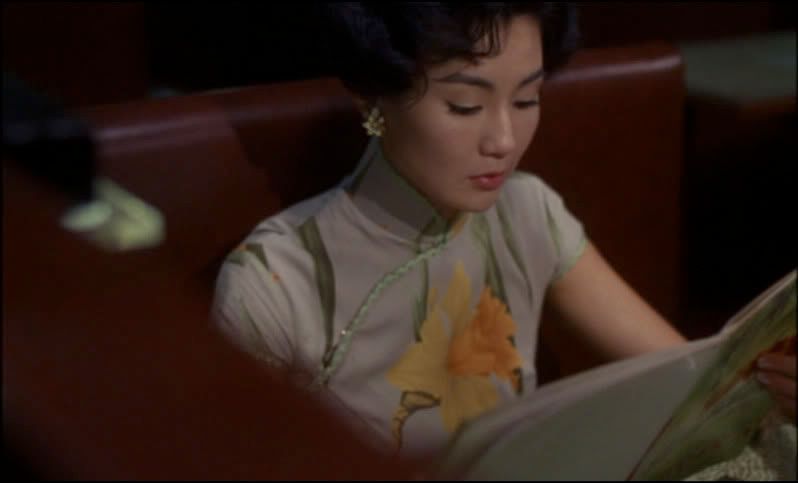
This same dress appears later on in the movie, seen full length, one of the rare times a qipao is repeated. The stylized cheongsam, the qipao, would seem to be one of the few garments capable of absorbing whatever colors and patterns the designers dream up, even full-length flowery chintz, but I think this has as much to do with the graceful bearing of Ms. Cheung. If you’ve ever sewn a garment, you’ll appreciate the fit of these dresses to this actress for the astonishing piece of dressmaking artistry it represents. And if you’ve ever wondered why Americans can’t seem to bring a gorgeously designed movie to the screen without a superhero anchoring it, this is your movie, which celebrates the intimacy of sharing food, the exuberant use of pattern and color, the bottomless depths of suppressed feeling expertly performed by virtuoso actors.
The exquisite music and, oh, the food, the dumplings, those noodles, bear equal billing. One of my favorite lines, because I was thinking the same thing is, paraphrasing: “She goes out dressed like that for noodles?” Yes, she does, gliding in the qipao, the thermos of noodles swinging at her side. Our neighborhood is just now getting some decent street food, little taco carts open til all hours just a block away, but to have a little thermos like the character of Mrs. Chan to fill with pork and noodles at the end of a workday — personal misery notwithstanding, dinnertime would be bliss.
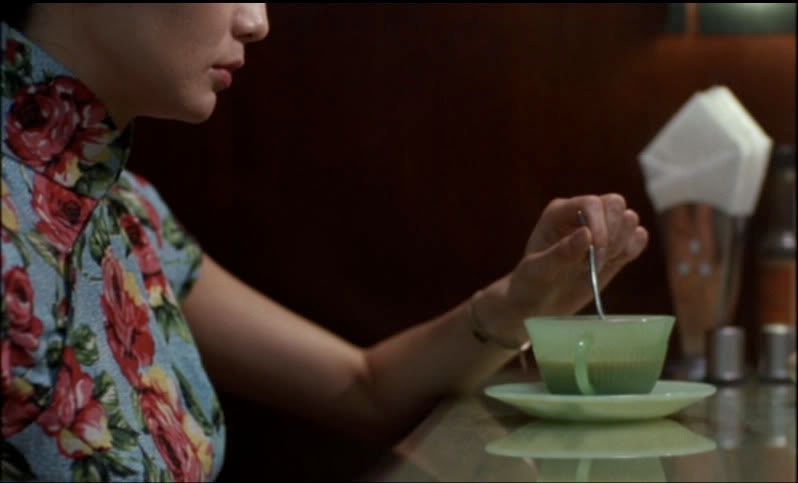
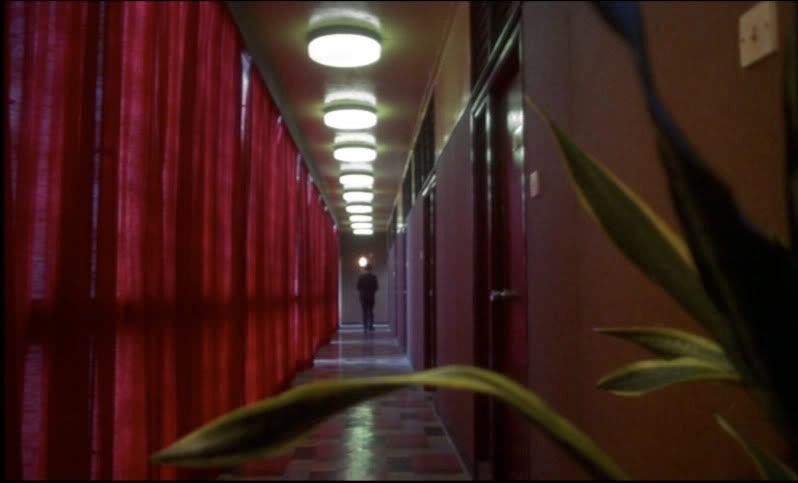
Elvis Costello does Penny Lane for his mum and the POTUS, filmed June 2, 2010, for PBS. I know I’m betraying both my age and a schmaltz streak a mile wide, but…
this is lovely. Well done, Elvis. I was too young to catch the Beatles, but Elvis and I go way back (1976 My Aim Is True).
Found at Open Culture
And of course the pretty nurse knew that, for cut flowers, she needed to sear the ends of the poppies with a lit match first, right?
There’s bound to be something doing well, no matter what the weather, if you just can’t keep yourself from stuffing all kinds of plants in your garden. Vegetable growers know this too well; the green beans crop in bushels while the tomatoes languish, but it also goes for ornamentals. The grasses might be having a good year while the tropicals sulk. It’s a rare year when everyone is happy.
A friend told me that the first 15 days of July along the coast in Southern California were cooler than the first 15 days of last January. This Blue Vine Sage has been having a fine summer with these record low temps.
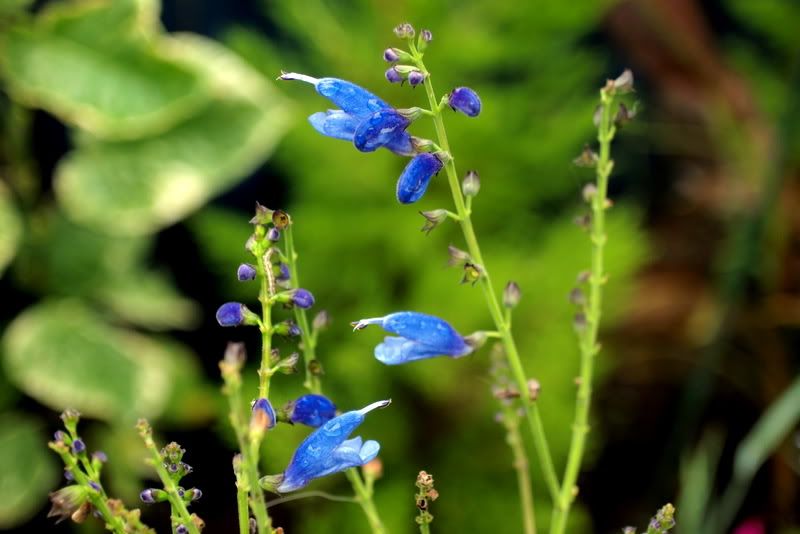
The leaves are constantly chewed upon, a culprit barely visible on the left in the above photo, but the flowers keep coming.

That this cool summer has been very much to the liking of this salvia is no surprise, since its habitat is the high pine and oak canopies of the mountains from its native Chiapas, Mexico, and in Guatemala and Honduras, 5000-8000 feet. It is believed that Strybing Arboretum in San Francisco and the Huntington Garden in Pasadena, California, introduced this salvia to California gardens in the 1970s (from Betsy Clebsch, The New Book of Salvias: Sages For Every Garden.) Hardy to 20 degrees but makes a great container specimen even when not in bloom, for its succulent, intensely green, triangular-shaped leaves and viny habit alone.
Salvias were a rabid enthusiasm about ten years ago. Although I don’t trial as many new ones currently, I always keep a few salvias in the garden. The hummers would probably go on a homicidal rampage otherwise. Salvias could patent the color cobalt blue.

Even a plant tough enough to be named the Cow Horn agave, A. bovicornuta, appreciates a little cloud cover and overcast skies.
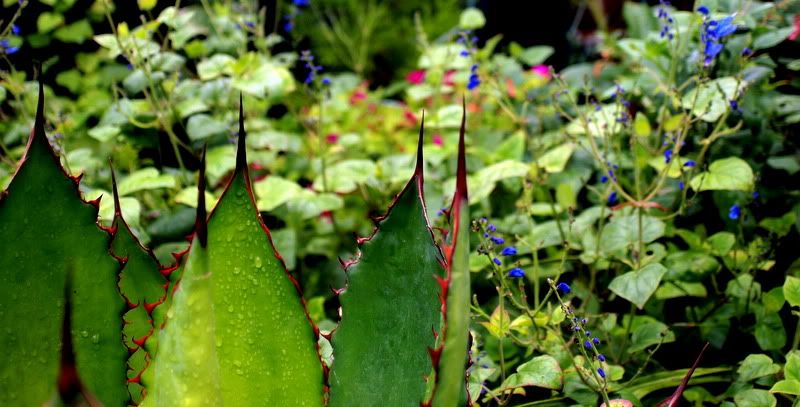
And I’m not complaining either.
The yucca has been a strong support to many this summer, in early summer the Geranium ‘Dragon Heart’ and now this coreopsis.

It seems the first question asked about these new coreopsis hybrids is: Do they flop? So let’s get that out of the way. On the floppage meter, ‘Full Moon’ rates a 7.

That’s an arbitrary rating system, of course, but it’s safe to say this coreopsis is not a tidy, self-supporting clump. It splays out and leans into the yucca, who fortunately can take the abuse. And that’s after giving this clump the “Chelsea chop” in early summer, cutting it back by half (named after the famed British garden show, which takes place in late May, about the same time that it’s best to cut back perennials to grow them more compact.) Since I don’t grow many perennials, I don’t mind this kind of wayward behavior from the few I do grow. I don’t have the space, climate, or the inclination for a bravura perennial summer show, but I do like the freshness a few can bring to mid-summer and usually binge on trialing a few new ones every fall.
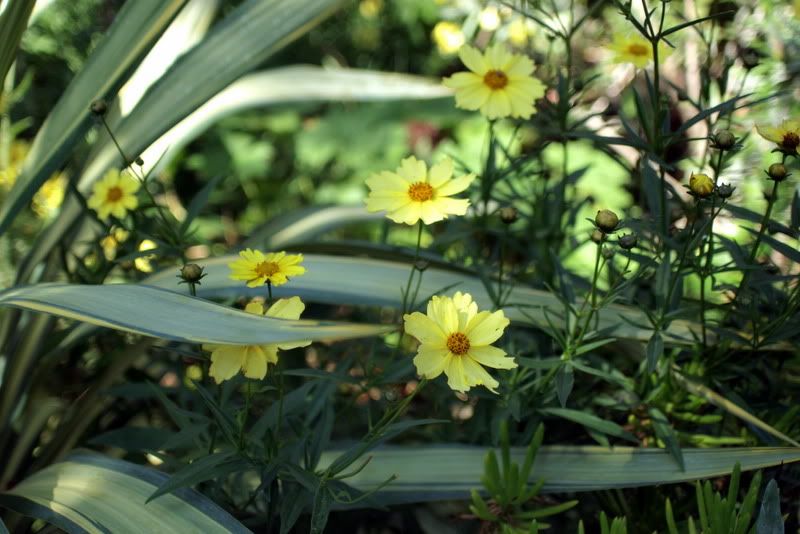
This is the coreopsis’ second year in my garden. This simple fact alone puts me solidly in its corner. Most perennials can’t make it through a zone 10, dormancy-free winter in cold clay soil. Once in bloom, judging from last year, this coreopsis will bloom until the cows come home, up into November here, and is very drought tolerant. A piece was stuck in the gravel garden in spring and is now in bloom, and sprawling less, too, in the even drier conditions there. Another clump deeper in the border didn’t get the Chelsea chop, and I was forced to cut a large section of it off yesterday that was smothering some yarrow. As floriferous as this coreopsis is, it won’t be missed.
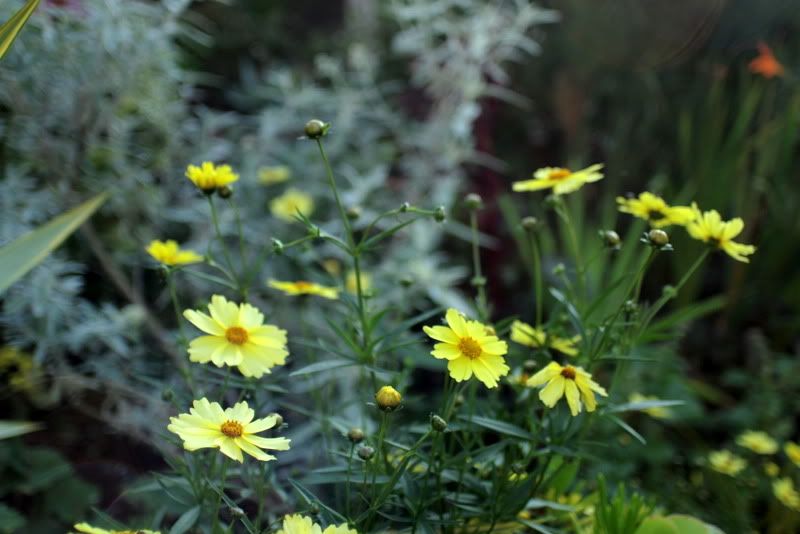
These coreopsis hybrids come from Darrell Probst, his secret recipe of perennial and annual species in new colors bred to be hardy to zone 5. ‘Full Moon’ has a bigger flower than the classic ‘Moonbeam,’ C. verticillata, the threadleaf tickseed, which has never enjoyed my zone 10 growing conditions. I love pale yellow daisies, my very favorite being anthemis, like ‘Susanna Mitchell’ or ‘Sauce Hollandaise,’ but I’ve run out of them at the moment. A small unnamed cutting of a buttery anthemis is being nursed along for next year.
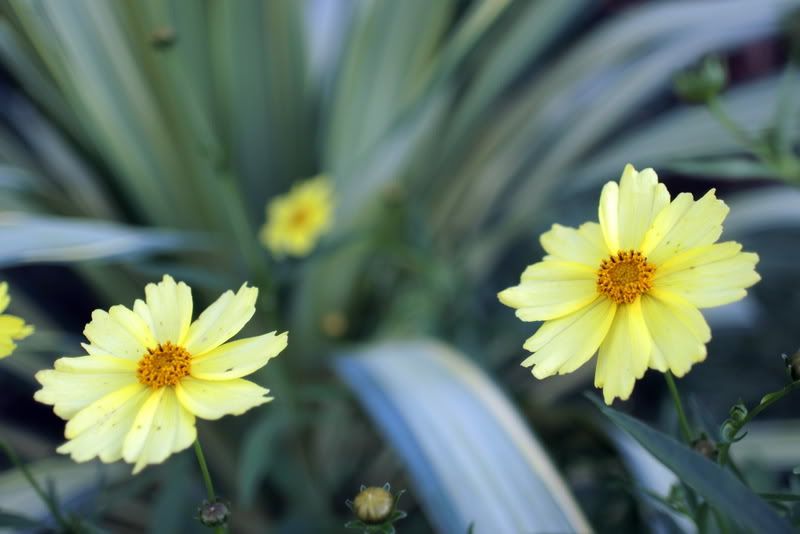
Yes, there’s a surfeit of yellow composites to choose from for mid to late summer, annual and perennial, if you’re so inclined. This exuberant one with a heart of gold suits me and my garden fine.
I suppose it depends on how much rampant serendipity you can tolerate from a willful little daisy.

Last year I popped a few more cuttings of this crassula amongst the Senecio mandraliscae, the bluish blur in the background, aptly named Blue Fingers or Blue Chalk Sticks.
Just the one bloom stalk from the crassula this year, but oh, how these two plants sing to each other. Quite the duet from Ol’ Blue Fingers and the Propeller Plant.
The crassula’s winged leaves have inspired the common names of Propeller Plant or Airplane Plant. Really makes me wonder about that moment in time when enough people have referred to a plant as, say, the Propeller Plant, for that to become an official common name. Also known as Sickle Plant (falcata means “sickle-shaped”), it was introduced from South Africa well over a century ago.
The newspaper delivery person has unerring aim for this bed of succulents, most of which can take an occasional hit, but not this crassula when it’s in bloom, or the agaves ever.
Since the newspaper is thrown stealth-mode out the window of a moving car in the early morning hours, there’s not much recourse. So no irreplaceable treasures are planted here. The steely blue bumper of Senecio mandraliscae growing around this bed does a pretty good job of absorbing some of the impact. The senecio’s insignificant flowers are in bloom now too.
San Marcos Growers says the crassula’s correct name is Crassula perfoliata var. minor, a name that’s rarely used. This photo of the entire plant is from SMG’s website.